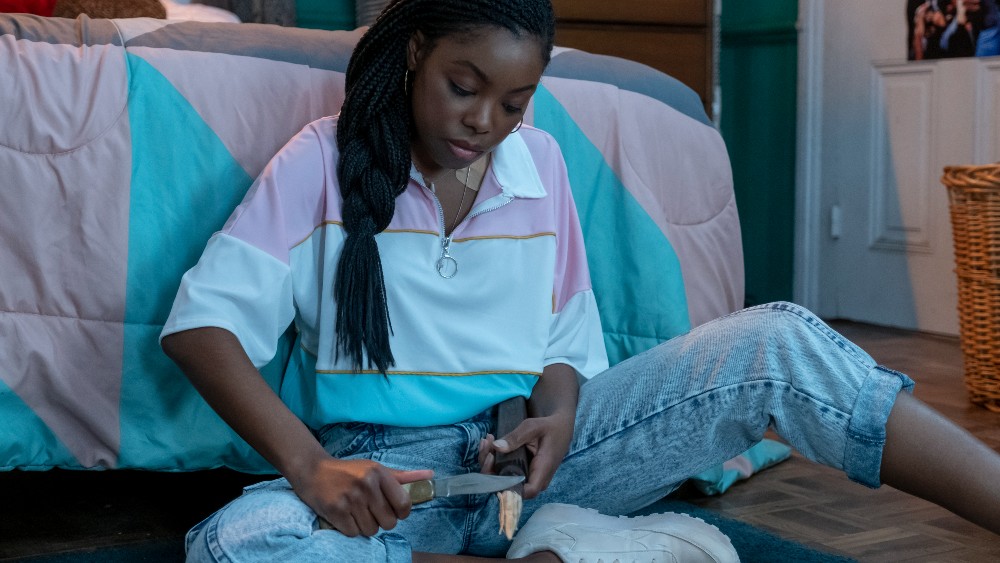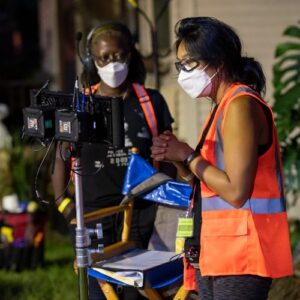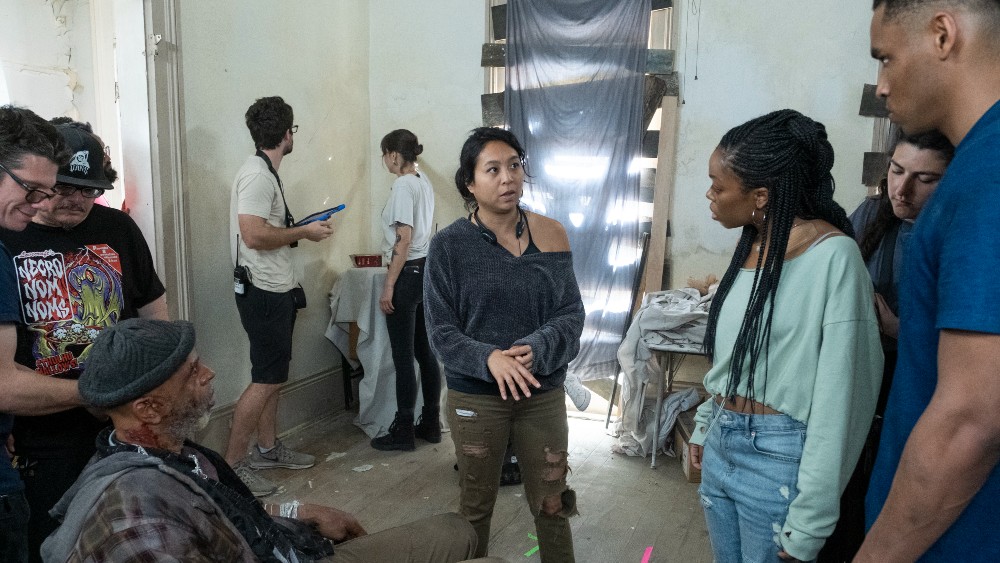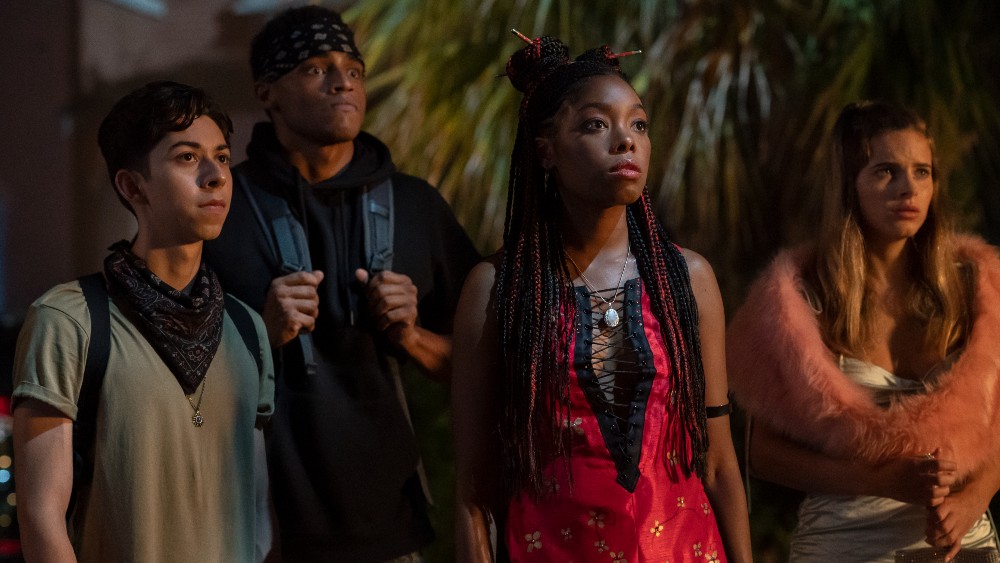
Last year, Below the Line talked to a few of the directors of Amazon Studios and Blumhouse Productions’ Welcome to the Blumhouse horror anthology series, and with Halloween coming up in just 30 short days, it seemed a good time to look at this year’s class.
Black as Night Director Maritte Lee Go has quite a long history as an indie producer, but she’s also directed eight shorts in the last ten years. Her film is a vampire movie set in Louisiana, and before you mention True Blood or Anne Rice, there is indeed a tradition in the Big Easy for the bloodsuckers. The ones in this movie are some of New Orleans’ homeless population, and it’s up to two young friends, played by Ashja Cooper and Fabrizio Guido to put a stop to them before they destroy their neighborhood.
You can read our interview with Ms. Go below, in which she proved to be quite lively and a positive breath of fresh air to the horror world.

Below the Line: How did this movie come about? I know Jason Blum had some scripts he needed to find directors for, but some of these were from directors who wrote their own scripts, too.
Maritte Lee Go: I actually pitched on the movie. I was pitching Amazon another horror film that I was developing, and they didn’t buy it, but they liked my point of view. And so, they had me pitch on the script. I read it and I fell in love with it, felt like it was so fresh, so new, and I had to be a part of it. I pitched it to Amazon and Blumhouse and got the job. Speaking into below the line stuff, I had been a line producer for almost a decade and producing indie features, very much in the same fashion as the Blumhouse model, all under a million-dollar budget movies, and kind of grinding my way through that and learning all the ins and outs of how to make a movie. It has always been my dream to make a horror film with Blumhouse, so that was really, really good training.
BTL: Is this officially your first feature? I know you’ve directed some shorts before.
Go: I had actually shot a feature called Rise that was shot in Africa and here in L.A. The producers were holding the movie, because it was going to be in a festival during the pandemic. The pandemic happened [and] kind of ruined everything, so I shot that first and then did an anthology horror film called Phobias after, but I was only one of five directors. And then, this is my second feature film.
BTL: I also know you produced Slight, which is a very cool film. When you say you pitched on the script, did they have a bunch of scripts and you picked one that you liked?
Go: So they only had this script that they showed me, and they were just looking for a director on it. So I read it, loved it, I put together a pitch packet with images and actors and locations and stuff on how I would direct it. And then, I cut together a rip reel of different movies to kind of show them the tone and how I would edit it and all that kind of stuff. That’s how I pitched on it, but I only pitched on this one movie.
BTL: I assume you had a lot of people you could call on to do the different roles for heads of department and DPs and stuff. Was Asjha someone you knew or had worked with before?
Go: Asjha Cooper, she’s actually somebody I auditioned. We auditioned hundreds of people and our casting was amazing, John McAlary. It was all through Zoom, which was great, but that was before the pandemic. But this is a way better way of casting because being in a room full of people all the time can be very exhausting. So we did 50-50, actually. We did Zoom and then we did some in person, but she was out of hundreds of people. Her audition was incredible, and I knew immediately. I was like, “That’s her.” And then we kept seeing people and I’m like, “Nope, it’s her,” and everyone agreed. She’s extremely talented. She’s a pro. This is her first lead role in a feature film, and, honestly, she felt so seasoned. I don’t know how it could be, but sometimes it’s just meant for you.

BTL: I saw that she had done a lot of television, but then, she has two horror films out this month, including one on Netflix. I know for the last batch of Welcome to the Blumhouse movies, they shot three of them in Louisiana with the same crew, back-to-back, so was that true with yours as well? Where were you in the shooting lineup for the second batch?
Go: I think we were the seventh, actually. They shot it like a TV show, so basically, the crew were all there. They had been working one after the other after the other, and they flew in the director and DPs and kind of switched them out. It was very much a well-oiled machine. I mean, the crew there is incredible. They’re so professional, so kind. A lot of them have been doing it so much longer than I have been alive, and they are just amazing to work with. I love the New Orleans community, and they’re just so kind. I can’t repeat that enough.
BTL: Had you been there before? How did you go about finding the locations? There are a lot of locations, even though there’s some scenes later that take place in the same mansion.
Go: I had been there like three or four times before — it’s one of my favorite cities ever. In my pitch packet, I actually screenshot different images of how I wanted each location to look, which was awesome, because I had screenshot this mansion that I’ve loved in New Orleans. I was like, “I love this place. I really hope it’s available,” and they were like, “It is.” So it’s the same mansion that I’ve found on Google Earth where they did Interview with a Vampire. It was kind of cool to have a connection to this iconic movie and have the same people work on my movie. It was pretty new to me. I had only been there for parties and stuff, so I was living there for a few months.
BTL: Was there any soundstage work as well? Did you build any of the interiors? (Note: Potential spoiler in next response.)
Go: The mansion was completely gutted from the inside. It’s hundreds of years old. The exterior is the way that it is. The top floor of it was apartments, but then the lower part there was nothing in it. The production design team put something amazing together for that. Everything else was real locations. No, we did build one stage to set that woman on fire. So that was really cool. It’s three different locations. So for the apartment, for the exterior, we have these buildings that look like the projects, then the interior is another apartment, where we did the whole scene where we see her on the couch. And then for the part where she explodes into flames, that was actually a stage that was built outside, ’cause you can’t really light somebody on fire inside a house or it will actually burn down. So that was really cool to set someone on fire and then also push them out of… I didn’t push them out. They jumped out of the window, three floors down and landed in like 200 boxes. That was really cool.
BTL: The movie has a little bit of everything. It has the vampires and gore, and it has some stunts. There have been a lot of vampire movies over the years, so were there any that inspired or influenced you or things you wanted to make sure you avoided? There may be some vampire tropes it’s hard to avoid.
Go: Especially in Louisiana. It was kind of a cross between two movies — Buffy the Vampire Slayer and 30 Days of Night, which is my favorite vampire movie of all time. There’s a lightness to it, it’s still funny, just like Buffy has a lot of funny moments, and we’re dealing with coming of age issues, and then also going into the darkness, which is what I love. I love horror, so I wanted to push it as much as I possibly could, and with limited time, it was difficult, but I wanted to get as dark as I possibly could within it.
BTL: It definitely felt like it could be a series. I feel like we could see more of these young people finding more vampires, different vampires, and fighting them. It was also nice seeing Keith David in the movie. I saw his name in the opening credits, but I’ve seen him in quite a few movies where he just pops up. Was it hard to get him? Is he based in Louisiana?
Go: I think he’s always traveling — he’s in everything. I think he’s got like 400 credits on his IMDb, but I think he lives in LA, but he’s constantly traveling and also recording at all times. He has voice-acted for every animation out there. I think at that time we were shooting, he was recording something for Mortal Kombat, and he’s just constantly working. But he’s not from New Orleans. I think he’s just an international man. He’s everywhere all the time.
BTL: I really loved the opening title credits and the music that creates a really cool vibe right away, so was that done with people you’ve worked with before?
Go: My composer, Jacques Brautbar — thank you for mentioning his music. I think he’s incredibly, incredibly talented. We went to USC together. He has composed for almost all of my short films. He’s so easy to work with, such a great human being, so he’s become a good friend of mine. We’ve been able to go from shorts to features now.
David, who did the animation is an incredible artist that I found on… do you know the website Art Station? It’s just this amazing website where you find thousands and thousands of artists. I knew a very specific look that I wanted in my head, but I searched through thousands of artists, and when I found him, I’m like, “Yes!” His stuff is terrifying. It’s so scary. He’s still up and coming and just excited to make horror just as I am. When I told him about the project, as soon as I gave him a little description of what I wanted, I was like, “Okay, cool. We’ll talk later. We’ll see we’ll work together.” And then, he literally started animating it right away. It came back to me with all these images, and I was like, “Yes, this is it, let’s do it!” And he did it so fast. That was originally in the script. I read some history within the lines of the lead vampire’s history, and I was like, “Man, I want to see more of that. I want to build out an antagonist with a very full rich life of how did he get to this place?” The easiest way to do it was through animation, just as they do in Harry Potter and Kill Bill. You’re able to do these really big fantastical things that you wouldn’t be able to afford on a budget like this, but be able to create this really full history.
BTL: I feel like they’re both going to get a lot more work from that intro.
Go: Oh, for sure.
BTL: What about the way the vampires explode into smoke, which is kind of cool? Obviously, it’s probably done using visual effects but was there some practical aspect to that as well?
Go: It was practical –we had to definitely kind of enhance it, but we took this air compressor, filled it with dust, and it just explode and go everywhere. At the same time, we’re kind of tweaking it with VFX and then also with their eyes, we enhanced that with VFX as well. But creating the way that they died was really fun. We got to work with the VFX people and the SFX people and practice on actors. We realized that with the limited amount of time that we had, how difficult it was to clean up, because it would ruin all their makeup, their hair, their wardrobe. So we could only, at max, do it twice without completely blowing our day. But it was really fun. I only hope to, if we were to do a sequel or a prequel, just keep pushing that envelope to do bigger explosions, because that’s really fun.
BTL: Do you know what you want to do next? Is there something you’re developing to shoot?
Go: I’m actually doing something different, very different. I’ve always dreamt of doing horror films, but another thing I’ve always wanted to do was a musical. I had made this short film that was like a musical that kind of went out everywhere, so I pitched on another film for Miramax — I’m in development now. We’re going to be shooting in the New Year, but we’ve been developing for like the last three months. And it’s very different from this movie, but there’s still a lot of similar themes that we explore.
Black as Night will premiere on Amazon Prime Video on Friday, October 1 i.e. today. Look for our interview with The Manor director, Axelle Carolyn, next week.
All pictures courtesy Amazon.






